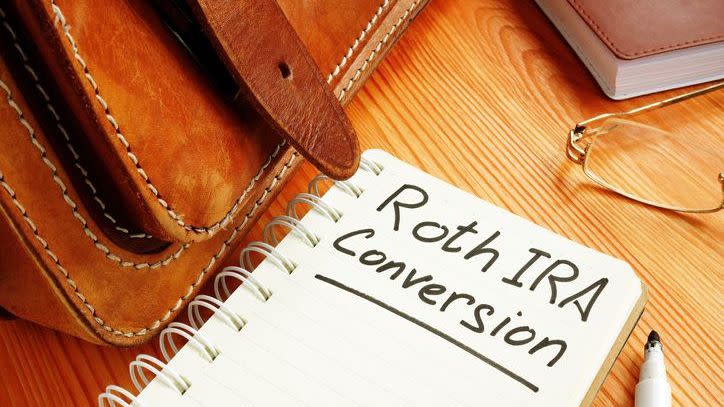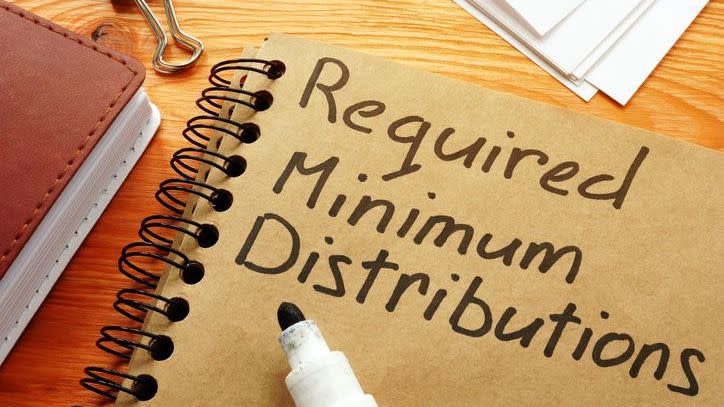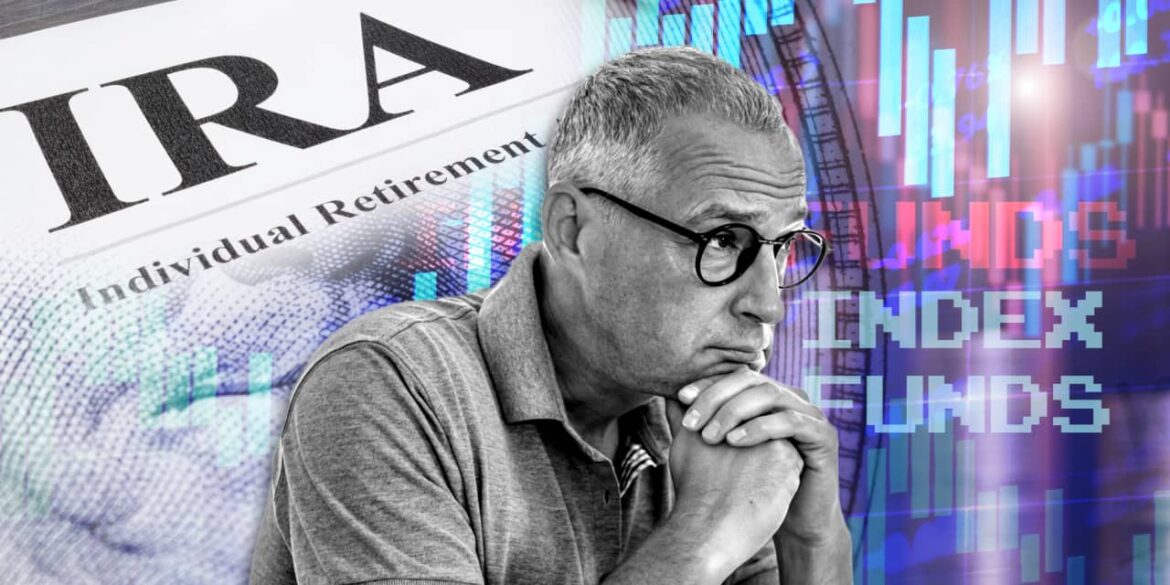
“Do I just have to ‘bite the bullet’ and pay the taxes?”
Source link
Roth
Roth IRAs are one of the most coveted accounts on the retirement scene for several reasons. For starters, you contribute after-tax dollars to the account so that you can enjoy tax-free income during retirement. Since you’re not required to withdraw money from the account during your lifetime, the money can keep growing, and you can pass it on to your heirs.
But you’ll want to jump on the benefits of a Roth IRA as soon as possible. Once your income jumps over the threshold, you won’t be able to make direct contributions to the account. So if you’re ready to unlock the power of a Roth IRA, here are three perks you don’t want to miss in 2024.

Image source: Getty Images.
1. Take advantage of the highest contribution limits ever
If you qualify to make direct contributions to a Roth IRA in 2024, you’ll be able to take advantage of the biggest contribution limits we’ve ever seen. This year, you can funnel up to $7,000 into a Roth IRA, provided your income sits below the threshold. And if you’re 50 or older, you can stash away as much as $8,000 as long as you plan to earn at least that much this year. These contribution limits jumped $500 over the cap for 2023.
Let’s say you qualified to contribute $8,000 every year. Within 13 years, you would be able to build a six-figure portfolio. Most likely, you’ll be able to hit six figures much faster if you invest in assets that generate superior returns. The more money you contribute to a Roth IRA, the more money you’ll have available to invest.
2. Invest in your favorite assets
If you’re working full-time, your employer probably offers some type of retirement plan, like a 401(k). For 2024, you can contribute up to $23,000 to the account, and your employer might even chip in a 401(k) match. But your 401(k) investment options are typically limited to a few investments, like index funds and target date funds.
Your Roth IRA offers more flexibility and freedom. You own and manage the account, so you’ll be able to decide what investments you can add to your portfolio. You could pump up your Roth IRA with a wide variety of traditional assets, including:
You could even look into a self-directed Roth IRA and gain access to more exotic assets, such as real estate, businesses, and digital currencies, that can supersize your returns. But you’ll want to make sure you understand the risks associated with these investments before you dive in.
3. Snag a Saver’s Credit
Contributions to a Roth IRA won’t lead to an up-front tax deduction, since they are made with after-tax dollars. But you may be eligible for a Saver’s Credit if your income isn’t too high. The IRS rewards low-and-moderate income retirement savers with a credit worth up to $2,000 ($1,000 if filing single) for making contributions to a qualified retirement account like a Roth IRA. Keep in mind that the Saver’s Credit is nonrefundable, so you won’t end up with a tax refund if your credit exceeds your tax bill.
This table shows whether you’re in the running for the Saver’s Credit. Your credit may be worth 10%, 20%, or 50% of your eligible retirement contributions, depending on your adjusted gross income and filing status.
|
Amount of Your Tax Credit Based on Income and Filing Status for 2024 |
Married Filing Jointly (AGI) |
Head of Household (AGI) |
All Other Filers (AGI) |
|---|---|---|---|
|
50% of your contribution |
$0 to $46,000 |
$0 to $34,500 |
$0 to $23,000 |
|
20% of your contribution |
$46,001 to $50,000 |
$34,501 to $37,500 |
$23,001 to $25,000 |
|
10% of your contribution |
$50,001 to $76,500 |
$37,501 to $57,375 |
$25,001 to $38,250 |
|
0% of your contribution |
Over $76,500 |
Over $57,375 |
Over $38,250 |
Data source: IRS.
If you qualify to make contributions to a Roth IRA and it makes sense for your portfolio, you want to do your research now so you can start taking advantage of the benefits. You may qualify for benefits right now, such as the Saver’s Credit, or position yourself to get more tax-free income during retirement.
I’m 60 With $1.2 Million in an IRA. Should I Convert $120,000 Per Year to a Roth to Avoid RMDs?

If you’re 60 years old with $1.2 million saved for retirement in a traditional IRA, you may be starting to think about required minimum distributions (RMDs) and the hefty annual tax bill they can create once you turn 73. Converting a portion of your IRA to a Roth IRA each year can help you reduce or avoid RMDs and take control of your tax bill – but also comes at a cost. Discuss your Roth IRA conversion questions with a financial advisor to determine if this strategy aligns with your broader financial plan.
RMD Rules: The Basics
Once you turn 73, the IRS requires that you start taking annual distributions called required minimum distributions (RMDs) from traditional IRAs, 401(k)s and similar tax-deferred accounts. RMDs are calculated by dividing your account balance by your life expectancy factor, a value that is set by the IRS based on your age.
RMD withdrawals are treated as ordinary income. With a large IRA balance, the size of the mandatory RMDs could easily push someone into a higher tax bracket and result in a higher tax bill. Remember, a financial advisor can be a valuable resource when it comes to planning for RMDs.
Roth Conversions

Roth IRAs, unlike traditional IRAs and 401(k)s, aren’t subject to RMD rules. So by converting your IRA to a Roth, you could avoid having to pay extra income taxes from mandatory IRA withdrawals in retirement. The catch is that you have to pay income taxes on the amount you convert at your ordinary income rate when you convert it. This can lead to a massive tax bill if you were to convert a $1.2 million IRA to a Roth all at once.
Instead, gradually converting your traditional IRA to a Roth IRA allows you to control when you pay taxes. Rather than unspecified mandatory RMD withdrawals, you choose when to take taxable Roth conversions. Roth withdrawals in retirement are then tax-free, provided you wait five years to withdraw those assets.
Keep in mind that the five-year period applies to each conversion. If you were to convert a portion of your IRA in 2024, 2025 and 2026, you’d have to wait until 2029, 2030 and 2031, respectively, to withdraw each group of funds tax-free.
If you need additional help navigating the rules surrounding Roth conversions, use this tool to match with a financial advisor.
A Roth Conversion Example
Assuming your investments grow at 5% each year for 13 years, your $1.2 million IRA could be worth around $2.3 million by the time you reach age 73. By that time, your first RMD would be approximately $87,000 based on the IRS life expectancy factor. Assuming you’re collecting $80,000 annually in taxable income from pensions and Social Security, adding an extra $87,000 would push you from the 22% bracket into the 24% bracket. (This assumes that the current tax brackets remain in place after 2025 when key provisions of the Tax Cut and Jobs Act sunset.)
But with 13 years of $120,000 Roth conversions already completed, the IRA balance requiring RMDs could be reduced to around $42,000 by age 73. Your first RMD would be just under $1,600. This would likely not push you into a higher bracket and save you thousands in annual taxes during retirement compared to taking the full $87,000 distribution without any prior Roth conversions.
The key is to not convert your entire IRA to a Roth immediately, but rather take an incremental approach. By limiting Roth conversions to a certain amount, you can control and potentially reduce your tax liability. Spreading conversions over time allows taxpayers to fill up their current bracket without exceeding it. By staying in lower brackets, more money is shielded from future taxes than paying the IRS immediately at today’s rates.
But you don’t have to do it all alone. A financial advisor can help you plan out your Roth conversion strategy and manage your taxes in retirement.
Roth Conversion Limitations

No matter how you do it, Roth conversions trigger taxes. Without sufficient non-retirement savings or other sources of income, investors may struggle to pay conversion taxes or be forced to sell investments at a loss. Optimal timing and tax planning are also challenging. Tax rates and laws can change frequently, making it hard to predict brackets decades in advance. Income fluctuations from bonuses, dividends or retirement plan withdrawals also complicate projections.
Converting too little defeats the purpose of avoiding higher future RMD taxes. But converting too much could push you into higher brackets now or reduce your flexibility if tax rates decline. Balancing present and future tax minimization is tricky with many uncertainties at play over long time horizons.
Additional factors may also come into play. Deductions that reduce taxable income, state taxes, fluctuating investment returns and income from other sources such as part-time work are all potentially important variables that need to be considered to craft the optimal strategy for Roth conversion. If you need additional help navigating these factors, consider working with a financial advisor.
Bottom Line
Roth IRA conversions let investors take control of the timing of their tax liability. By paying taxes now at known rates through incremental conversions, overall lifetime taxes can be reduced compared to unpredictable mandatory RMD withdrawals decades into the future. But Roth conversions come at a cost today, require non-retirement funds to pay taxes, and involve considerable analysis and some guesswork to optimize.
Retirement Planning Tips
-
A financial advisor can help develop Roth IRA conversion strategies. Finding a financial advisor doesn’t have to be hard. SmartAsset’s free tool matches you with up to three vetted financial advisors who serve your area, and you can have a free introductory call with your advisor matches to decide which one you feel is right for you. If you’re ready to find an advisor who can help you achieve your financial goals, get started now.
-
Knowing how much money you’ll need to retire and whether you’re on track to hit that target is vital when you’re planning for your golden years. SmartAsset’s retirement calculator can help you estimate how much you may have in savings when the time comes for you to retire.
Photo credit: ©iStock.com/monkeybusinessimages, ©iStock.com/designer491, ©iStock.com/designer491
The post I’m 60 With $1.2 Million in an IRA. Should I Convert $120,000 Per Year to a Roth to Avoid RMDs? appeared first on SmartReads by SmartAsset.
Make the Most of a Roth Conversion With These Strategies from Schwab

Converting a traditional IRA to a Roth IRA can help you minimize taxes in retirement. But executing the conversion strategically is key to maximizing the benefits. A recent Schwab retirement planning report recommends three tactics to reduce your Roth conversion tax bill: max out your current bracket, spread conversions over multiple years and start planning early for tax changes. Any or all can be effective retirement planning tools, but a Roth conversion comes with costs, limits and risks and may not be optimal for everyone.
Do you need help building and managing your retirement plans? Speak with a financial advisor today.
What Is a Roth Conversion?
With a Roth conversion, you can move funds from a traditional IRA to a Roth IRA and pay income taxes on the amount converted. This can benefit you in retirement by letting your savings then grow and be withdrawn tax-free. It’s a savvy strategy if you expect to be in a higher tax bracket later in retirement or want to avoid required minimum distributions (RMDs) on traditional IRAs.
The mechanics of Roth conversion aren’t particularly difficult and the institution that holds your Roth account can help. But it’s up to you to make sure that you don’t pay too much in taxes. The Schwab Center for Financial Research recently offered three potential ways to reduce the tax hit of your Roth conversion:
1) Max out your current tax bracket with a partial conversion. This seeks to avoid being bumped up to the next bracket by adding smaller amounts to your taxable income each year. For example, if you’re in the 24% bracket, convert just enough funds to bring your current taxable income up to the next bracket’s threshold.
2) Spread out conversions and break them up over several years to control the tax impact. As with the previous strategy, this seeks to avoid being bumped up to the next bracket by adding smaller amounts to your taxable income each year. Stay strategic to maximize each year’s bracket.
3) Think about tax changes nice and early. If you think tax hikes are coming, you can convert more now to avoid higher rates later. Convert before year-end to account for income fluctuations.
A Roth Conversion in Action

To see how this might work, consider a hypothetical example of a single retirement saver who has $200,000 in a traditional IRA. They think their tax rates will be higher in retirement, so they’d like to convert that to a Roth. They make $150,000 annually, putting them in the 24% bracket. For 2023, the next bracket starts at $182,101, with a rate of 32%, and the bracket above that is 35% and applies starting at $231,251.
If they converted the full $200,000 to a Roth IRA in one year, here is how their tax liability would break down on that money specifically:
-
On the first $32,100, they would owe 24%, or $7,704
-
On the next $49,150 they would owe 32%, or $15,728
-
On the remaining $118,750, they would owe 35%, or $41,562
In total, they would owe $64,994 in income taxes on the full one-time $200,000 conversion.
If they used a gradual conversion strategy, they could convert $32,100 this year to increase their income to $182,100. This fills her 24% bracket without moving up to the higher rates. At the 24% marginal rate, she’ll pay approximately $7,704 on the converted funds.
Assuming their income and the tax brackets don’t change, they can repeat this over the next several years to gradually move the entire $200,000 in their IRA to a Roth.
Without brackets changing, in each of the first six years, they could convert $32,100 and pay $7,704 in taxes for a total six-year tax bill of $46,224. In the seventh year, they could convert the remaining $7,400, paying $1,776 in tax.
Their total seven-year tax bill for the gradual conversion would come to $48,000. That represents a hypothetical tax savings of $16,994, although in reality the tax brackets as well as their annual earnings would likely shift to produce a somewhat different schedule of withdrawals and outcome.
Roth Conversion Costs, Limits and Risks
While a Roth conversion can be a smart move, it’s not without potential drawbacks. For instance, although Roth conversions can optimize your retirement taxes, they incur extra tax costs now.
Also bear in mind that Roth conversions are irreversible. You can’t undo it and move funds back to a traditional IRA or other pre-tax retirement account.
Finally, if you’re under 59.5, pulling money from an IRA is considered an early withdrawal. That means the funds you plan to convert must pay a 10% penalty in addition to taxes owed before you can put them into a Roth account.
How to Decide If Roth Conversion Is Right for You

Roth conversion can make sense, but it’s not always the right move for every retirement saver. Before deciding to do a conversion, consider your individual circumstances carefully.
Look especially at your current tax bracket versus your expected retirement income and tax rates. Weigh the benefits of tax-free retirement withdrawals against paying conversion taxes now. Align conversion years with lower income. For larger IRAs, discuss partial conversions with a tax pro.
Bottom Line
Strategic partial Roth IRA conversions can optimize your retirement taxes. But work through the analysis to see if conversions align with your overall savings and tax picture. Enlist help from a financial advisor to run the numbers. With the right plan, you can make the most of this IRA planning tool.
Retirement Planning Tips
-
You may want to consider working with a financial advisor to project your retirement income and tax rates and see if a Roth conversion can work. Finding a financial advisor doesn’t have to be hard. SmartAsset’s free tool matches you with up to three vetted financial advisors who serve your area, and you can have a free introductory call with your advisor matches to decide which one you feel is right for you. If you’re ready to find an advisor who can help you achieve your financial goals, get started now.
Photo credit: ©iStock.com/Dilok Klaisataporn, ©iStock.com/designer491, ©iStock.com/skynesher
The post Make the Most of a Roth Conversion With These Strategies from Schwab appeared first on SmartReads by SmartAsset.

If you’re taking a required minimum distribution from an IRA, 401(k) or other tax-deferred account and don’t need the money to cover living expenses, where should you stash that unneeded cash?
Investors now need to start taking RMDs at age 73 or, if they were born after 1960, at age 75. Depending on the balances of your accounts, that distribution can be a sizable amount of money, perhaps more than you need to live on. One option is to reinvest that money, and a Roth IRA would seem to be a perfect choice: withdrawals from Roth accounts are tax-free – including all gains on your investments – and you’ll never need to take any of those pesky RMDs during your lifetime.
There’s just one catch: You can’t directly convert your RMDs to a Roth. But for some people, there is a potential workaround. For 2024, you can contribute up to $7,000 plus another $1,000 if you’re at least 50 years old – if you have enough earned income.
Get matched with a financial advisor to discuss your own retirement strategy.
What is – and isn’t – ‘earned income’
The IRS defines earned income as money you get for working, such as wages, commissions, bonuses, tips and honorariums for speaking, writing or taking part in a conference or convention. Income generated by self-employment also counts. Income that doesn’t qualify includes taxable pension payments, interest income, dividends, rental income, alimony and withdrawals from Roth IRAs or other nontaxable retirement accounts, along with annuities, welfare benefits, unemployment compensation, worker’s compensation payments and your Social Security income.
Another restriction on Roth contributions is the income limit. Once your modified adjusted gross income (MAGI) hits $146,000 for a single filer or $230,000 for joint filers, your maximum Roth contribution starts phasing out up to $161,000 (single filers) or $240,000 (joint filers). After that, you’re no longer eligible to contribute.
You also need to remember that you need to wait five tax years after your first contribution to any Roth account before you can make withdrawals. Heirs who inherit your Roth will need to withdraw the entire balance within 10 years.
Consider speaking with a financial advisor to develop a tax-efficient retirement strategy.
Other options on RMDs
If you don’t qualify to make a Roth contribution, you still have options to eliminate, reduce or delay your RMDs.
Roth conversion: You can convert your IRA to a Roth account, once you’ve taken your RMD for the year. You’ll pay taxes on the amount you convert, so one tactic is to convert the maximum amount available without pushing yourself into a higher tax bracket. Each Roth conversion carries its own five-year rule.
Charitable contribution: You can use a Qualified Charitable Distribution to donate some or all of your RMD to a charity recognized by the IRS and you won’t be taxed on the donated amount. To qualify, the money must be transferred directly from your IRA to the charity.
Keep working: Your 401(k) account with your current employer isn’t subject to RMDs if you’re still on the payroll. One tactic is to roll 401(k)s from previous employers into your current plan so that they won’t be subject to RMDs. Once you stop working, however, RMDs are required.
Be careful: The punishment for failing to take an RMD during the required time period is a hefty one – up to 50% of the missed RMD amount.
A financial advisor can help you navigate the particular risks and tradeoffs in your situation.
Pay attention to all your taxes
Structuring your retirement withdrawals to reduce your tax bite means looking at all your sources of income, including retirement accounts, RMDs, Social Security benefits, pensions and taxable investment income. For some people, withdrawing money from an IRA early in retirement can reduce the size of their eventual RMDs. If they also delay collecting their Social Security benefits, their benefit amount to increase by 8% each year until they reach 70 years old. Also, be sure to coordinate taxes, withdrawals and RMDs between spouses, and remember that a younger spouse’s RMDs won’t need to be taken until they reach age 73 or 75.
Other common retirement tax moves include investing in tax-free bonds, moving to a state with no income tax or estate tax, harvesting tax losses in taxable investment accounts and holding any taxable assets long enough to qualify for lower long-term capital gains tax rates.
To learn more about retirement planning and how to work toward your goals, talk to a financial advisor for free.
Bottom line
How to manage your RMDs – and all the other many tax questions that can arise in retirement – can be complicated. Take the time to estimate your retirement taxes before you start collecting pensions, Social Security and taking withdrawals from retirement accounts.
Tips
-
Balancing taxes and retirement income – and figuring out how to minimize taxes in retirement – is a crucial issue. A knowledgeable financial advisor can help you decide how to structure and coordinate these payments over the span of your retirement.
-
Finding a financial advisor doesn’t have to be hard. SmartAsset’s free tool matches you with up to three vetted financial advisors who serve your area, and you can interview your advisor matches at no cost to decide which one is right for you.
-
Make sure you’re protecting your cash reserves from inflation by securing them in an account that generates a competitive interest rate. Leaving cash in a checking account or low-yield savings account can stifle your purchasing power over time.
Photo credit: ©iStock.com/skynesher
The post Can I Use My RMDs to Transfer Money Into My Roth IRA? appeared first on SmartReads by SmartAsset.
You should expect to need savings on top of Social Security once your retirement kicks off. But you have options when it comes to choosing a home for your nest egg. Those might include a traditional IRA, a Roth IRA, or a traditional 401(k) plan offered by your employer.
These days, though, a growing number of 401(k) plans are including a Roth savings feature. And that’s an option you may be tempted to take advantage of — especially this year because Roth 401(k)s are no longer forcing savers to take required minimum distributions.

Image source: Getty Images.
While a Roth 401(k) might seem like a great home for your retirement savings, there are certain pitfalls you might encounter if you choose one of these accounts. Here are three reasons you may not want a Roth 401(k) to serve as your nest egg’s home.
1. You have limited investment choices
The nice thing about saving for retirement in an IRA is that you get a world of investment options to choose from. Want to load up on individual stocks you research yourself? Go for it.
With a 401(k), you’re generally limited to several different funds. Within that realm, some funds may come with lower expense ratios than others. Either way, you’ll still be limited as to how you invest your retirement savings, so an IRA may be a better bet.
If you want the benefit of tax-free investment gains and withdrawals, you can always choose the Roth version of an IRA. Even if your income is too high for a Roth, there’s always the conversion option.
2. Your plan fees are high
The investments you choose for your 401(k) could leave you paying a lot of money in fees. But even if you opt for low-cost investments, like index funds, you might still get hit with fees associated with administering your 401(k).
Those fees, like investment-specific fees, could eat away at your returns over time. With an IRA, your fees may be lower.
3. There’s no employer match
Contributing to a 401(k) plan makes sense when there are employer-matching dollars to take advantage of. Data from Vanguard finds that within its platform, 95% of retirement plans come with some type of matching contribution on the part of a sponsoring employer.
But if you’re in that unlucky 5%, it may not be worth it to contribute to a Roth 401(k) if the above circumstances apply to you. If there’s no workplace match, you may want to max out an IRA first. Then, if you wish to contribute beyond that point, you can divert extra funds to a Roth 401(k).
You may also want to keep some of your retirement savings outside a tax-advantaged account. That way, your money will be completely unrestricted.
Roth 401(k)s give you many of the benefits of Roth IRAs but with higher contribution limits. As you can see, however, there are drawbacks to making a Roth 401(k) the home for your retirement savings, so you may want to consider a different solution.
My RMDs Start Soon So I’m Converting $700k to a Roth, But I’m Getting Conflicting Info About Having to Wait Five Years

I’m 68 and recently retired and have about $1.4 million in accounts intended for retirement ($1.2 million in a Traditional IRA and $110K in a Roth). I also am receiving about $47,000 annually in Social Security benefits. My RMDs are scheduled to start in 2027, and as a result, my financial advisor and I are considering doing some annual Roth conversions prior to 2027. It all sounds like a good plan to me, however, I am getting some conflicting information on when I will be able to make withdrawals from the Roth.
My advisor says I will have to wait the standard five years after each Roth conversion deposit before being able to make any withdrawal of those funds (the conversion amount itself and any earnings). However, I have also been told I could withdraw against the conversion amount with no waiting period since I am older than 59 ½. For example, my Roth was established in 2015 and has had a total of $60,000 in contributions and $50,000 in earnings. If I were to do a Roth conversion of $75,000 in 2024 would I then have available $135,000 for withdrawal without any penalty? My advisor says I would only have the original $60,000 available for withdrawal until the five years have passed for the conversion made in 2024. What is the proper withdrawal regulation and rules under those circumstances?
– Jeff
Hey Jeff, great question. This is unfortunately a very confusing topic that is easily jumbled up. It is not surprising that you’ve received or found conflicting information. Fortunately, once you sort through the rules and are able to keep them straight, the answer is very clear.
Because you are over 59 ½ and have had a Roth IRA for five years, you can withdraw any amount of money at any time from any Roth IRA balance you have (conversion or otherwise) without incurring a tax liability or penalty. Period.
Having said that, I am now just another guy that has given you information that conflicts with something else you’ve heard, right? Rather than leaving it at that, let’s walk through the rules and reference the specific information from the IRS. (And if you’re need financial advice or want to find a new advisor to work with, this free tool can help you connect with financial advisors who serve your area.)
What Are the 5-Year Rules?
While Roth IRAs are funded with after-tax money that can be withdrawn tax-free, there are specific rules surrounding how to take this money out of your account.
The IRS has three “five-year rules” for different types of Roth IRAs, but we’ll be discussing two of them here. The first five-year rule specifically applies to accounts that start off as Roth IRAs, while a separate five-year rule solely applies to accounts that are converted into Roth IRAs. Keep in mind that running afoul of either rule can trigger a 10% early withdrawal penalty and/or income taxes on investment earnings. You’ll obviously want to avoid these taxes and penalties as best as you can.
5-Year Rule for Roth IRAs

The first five-year rule dictates that you must wait five years after your initial contribution to a Roth IRA before you can make tax-free withdrawals of any investment earnings. However, the five-year period is retroactive to Jan. 1 of the year in which your first contributions were made.
For example, if you made your first contribution to a Roth IRA in November 2020, the five-year period officially began on Jan. 1, 2020. As a result, you could start withdrawing earnings after Jan. 1, 2025.
But waiting five years alone is only half of the equation. Withdrawals from your Roth IRA must be “qualified” in order for you to avoid taxes and penalties. Luckily, reaching age 59 ½ is the most common way to satisfy this particular requirement.
For instance, funding a Roth IRA at age 45 doesn’t mean someone can make tax- and penalty-free withdrawals from the account five years later. They’ll need to wait until age 59 ½, be disabled or meet one of the other requirements set by the IRS for qualified withdrawals. Likewise, if you open your first Roth IRA when you’re 58, the five years still need to pass before you can withdraw the earnings tax-free. Simply turning 59 ½ isn’t enough in this instance.
Failing to meet both the five-year rule and the rules governing qualified withdrawals may trigger income taxes on the earnings you withdraw, as well as a 10% tax penalty. Jeff, because you opened your Roth IRA in 2015 and you are over 59 ½ years old, you have already satisfied both rules. Plain and simple.
(And if you need help managing your Roth IRA, consider connecting with a financial advisor who serves your area.)
5-Year Rule for Roth Conversions
There is also a separate five-year rule for Roth conversions. If a person is under 59 ½ years old, they must wait five years before they can withdraw any money that’s converted from a traditional IRA into a Roth IRA. And unlike the first five-year rule that only needs to be satisfied once, this rule applies to each individual conversion.
Fortunately, you aren’t subject to early withdrawal penalties by virtue of your age, so this five-year rule also doesn’t apply to you. You’ll automatically avoid the 10% penalty on withdrawals from a converted Roth IRA.
However, here’s the context and rationale for this IRS rule:
Someone who’s under 59 ½ is generally subject to an additional 10% penalty on distributions from IRAs. Without this five-year rule, someone could simply convert a traditional IRA into a Roth IRA (paying the taxes on the conversion, of course) and then immediately withdraw the money from the Roth IRA, thereby sidestepping the 10% early withdrawal penalty. The five-year rule on Roth conversions closes this potential loophole.
Keep in mind that each five-year period starts on Jan. 1 of the year in which the conversion was made. (And if you need help doing a Roth conversion, consider speaking with a financial advisor who can guide you through the process.)
Bottom Line
As they say, age has its privileges. Because you are over 59 ½ and have satisfied the Roth IRA contribution rule, you no longer have to worry about taxes or penalties on any withdrawals you take from your Roth IRA.
Tips for Finding a Financial Advisor
-
Finding a financial advisor doesn’t have to be hard. SmartAsset’s free tool matches you with up to three vetted financial advisors who serve your area, and you can have a free introductory call with your advisor matches to decide which one you feel is right for you. If you’re ready to find an advisor who can help you achieve your financial goals, get started now.
-
If you’re working with a financial advisor but you’re unhappy with the results, you can always consider finding a new professional to work with. Here are some tips for navigating this transition, including how to notify your current advisor about your decision and what you should do before breaking off the professional relationship.
Brandon Renfro, CFP®, is a SmartAsset financial planning columnist and answers reader questions on personal finance and tax topics. Got a question you’d like answered? Email AskAnAdvisor@smartasset.com and your question may be answered in a future column. Questions may be edited for clarity or length.
Please note that Brandon is not a participant on the SmartAsset AMP platform, and he has been compensated for this article. Questions may be edited for clarity or length.
Photo credit: ©iStock.com/Kameleon007
The post Ask an Advisor: My RMDs Start Soon So I’m Converting $700k to a Roth, But I’m Getting Conflicting Info About Having to Wait Five Years appeared first on SmartReads by SmartAsset.
I’m 52. Should I invest in a Roth IRA or index funds like the Dow and Nasdaq?

Dear MarketWatch,
I spent five years as a teacher in Missouri, which made me eligible for a tiny pension (under $400 per month).
Teaching didn’t work out for me, and since I will never be able to return to the profession and increase my pension, I decided to cash in my pension and reallocate the funds to something that would pay more.
I paid down some debt and then invested $6,500 — the maximum allowable amount — into a Roth IRA. I’m 52 but don’t plan to retire for at least another 20 years.
Once I’m done with my taxes, I am not certain whether I should put the remaining funds in the IRA or invest them in index funds like the Dow or Nasdaq. What is your advice?
Related: I’m 73, retired and take my RMDs. But what happens if I become incapacitated and miss them for several years?
Dear Reader,
I’m going to answer your question with a question. Why choose one over the other when you can have both? Index funds are a popular choice for investors with IRAs, so there’s no reason why you couldn’t add them to your Roth IRA’s portfolio.
For those who may be unaware, and as the name suggests, index funds use indexes, such as the S&P 500
SPX,
Dow Jones Industrial Average
DJIA,
Nasdaq Composite,
COMP,
or many others, as benchmarks. They’re particularly useful for long-term investing, which makes them a good choice when your retirement is a couple of decades away.
When you have your retirement investing plans on the radar, but aren’t sure where to start, look at target-date funds. Managers link these portfolio funds to specific years for retirement — say, 2030 or 2055. If your retirement is 20 years away, you could look at a target-date fund for 2045. (Keep an eye on fees, also called expense ratios.)
I am not a financial planner — specifically, not your financial planner — so I do not provide specific investment advice. Any funds I mention here are simply to illustrate and explain how they work and what to look for.
Target-date funds
Back to the target-date fund. If you look at Vanguard Target Retirement Fund 2045, VTIVX you will see under “holdings” that half of that fund is invested in Vanguard’s Total Stock Market Index Fund VSMPX, another 33% is in Vanguard’s Total International Stock Index Fund VGTSX, 10% is in the company’s bond-market index fund VTBIX, 4% is in Vanguard’s international bond index fund VTILX, and 1% is in liquidity. Take it a step further, using the total stock-market index fund as an example, you’ll see the top 10 holdings include Apple,
AAPL,
Microsoft,
MSFT,
Amazon,
AMZN,
and NVIDIA.
NVDA,
Vanguard is far from the only company that offers target-date funds or index funds. Other big names include Fidelity, Blackrock
BLK,
T. Rowe Price
TROW,
Schwab
SCHW,
and American Funds . You can make a day of searching their options and comparing holdings.
Another option you have is to invest in a traditional IRA right now if you’re in a higher tax bracket than you expect to be in the future (though not including assumptions about tax brackets when they sunset in 2025). As your tax liabilities drop, you can convert some of those funds into your Roth account. Having a Roth IRA is a great tool for retirement savings, and diversifying your investments and your taxability will make any option you have in the future even more powerful.
Have a question about your own retirement savings? Email us at HelpMeRetire@marketwatch.com
I Was Planning on Taking My RMDs and Converting Them to a Roth, But Was Told I Can’t. Is That True?

If you’re looking for a tax-savvy way to deal with you required minimum distributions (RMDs), converting them into a Roth IRA isn’t an option.
A financial advisor can help you plan for RMDs and figure out if a Roth conversion is right for you.
It’s relatively common for retirees to need a plan for their required minimum distributions. That’s particularly true for households that don’t need their RMDs to cover living expenses and other spending needs. While you can reinvest these withdrawals in taxable accounts, the IRS restricts how you can fund tax-advantaged accounts like a Roth IRA.
Among those restrictions: you can only make IRA contributions with earned income. As a result, you can’t use RMDs to directly fund a Roth IRA.
What Are RMDs?

Starting at age 73 (or 72 depending on your birthdate), the IRS requires you to begin withdrawing a minimum amount each year from your pre-tax retirement accounts, such as 401(k) plans and IRAs. The exact amount depends on your age and the amount in your portfolio. To calculate your RMD, you divide the portfolio’s balance at the end of the year by a published life expectancy factor.
For any given year that you don’t take the full distribution, the IRS will charge you a tax penalty of either 10% or 25% of the amount that’s not withdrawn. For example, say that you don’t withdraw a required $10,000. You could face a tax penalty of up to $2,500.
The IRS requires you to take RMDs from tax-deferred accounts because each withdrawal is a tax event that triggers income taxes. Since you’ve already paid taxes on the money in Roth accounts, the IRS doesn’t require you to take minimum distributions from them. But if you have additional questions surrounding RMDs, consider speaking with a financial advisor.
Can You Invest RMDs in a Roth IRA?
For some retirees, the problem with a required minimum distribution is that they don’t need the money yet. This comes up, particularly for people who alreasdy sufficient income streams or those who hold multiple accounts and want to draw them down one at a time.
While you have several options for how to manage these distributions, you cannot reinvest them in a Roth IRA.
Roth IRA Requirements
You can only make IRA contributions with what’s called “earned income. This is defined as money that you receive from wages, salary, contract income and other forms of work. You cannot make contributions to an IRA – whether its a traditional or Roth account – from investment proceeds, capital gains or many passive income streams like rental properties.
This means that you’re free to get a job in retirement and put that money into a Roth IRA for later in life. However, you cannot withdraw money from a portfolio and transfer it into a Roth IRA or any other form of tax-advantaged retirement account. The IRS discusses this restriction in full in Publication 590-A.
Conversions Are Also Restricted
This subject can get confusing because of the overlap between a withdrawal and a conversion. When you have a pre-tax portfolio, like a 401(k) or an IRA, you are allowed move money directly into a Roth IRA in what’s called a conversion. You take out a lump sum of money from a tax-deferred account, pay income taxes on the amount and deposit it into the Roth IRA.
However, the IRS specifically prohibits you from converting any required distributions into a Roth IRA. You can convert money that isn’t a required distribution, but the law is unambiguous that you cannot do so with an RMD. Navigating the IRS rules for RMDs and Roth conversions can be confusing, which is way you may want to consider connecting with a financial advisor.
Alternative Options for Roth IRAs and Required Minimum Distributions

So, what should you do instead? For retirees, there are a couple of options for how to manage RMDs.
First, you can convert the rest of your pre-tax portfolio after you meet the RMD requirements. In any year with an RMD, the first dollars you withdraw from that account are treated as part of your RMD. Once you meet the minimum amount, you’re free to convert the rest of your account (in whole or in part) into a Roth.
Say you have a $10,000 RMD in a given year. You first must withdraw that $10,000 before you may convert any remaining, eligible amount in your retirement account to a Roth IRA. As always, when doing so remember that Roth earnings have a five-year cooling-off period, so make sure you won’t need this money right away. And if you withdraw any of the money you convert before the five-year period is up, you could owe a 10% penalty on the money (unless you’re age 59 ½ or older).
Second, it is common for retirees to reinvest their minimum distributions. While you can’t put this money back into a tax-advantaged retirement account, you can put it into a taxable investment portfolio. The exact nature of these investments will vary based on your financial strategy and needs. Some retirees may do well investing for growth, taking money that they don’t need and putting it into equity-heavy funds. Others may do well investing for security, taking money that they will need someday and putting it into bond-heavy funds or annuities.
But if you need additional help reinvesting your RMDs, a financial advisor can help you make a plan to put this money to work for you.
Bottom Line
You cannot reinvest required minimum distributions in a Roth IRA. While you can convert any remaining amount from your pre-tax retirement account, the IRS specifically prohibits you from putting RMD funds in a tax-advantaged portfolio. However, RMDs don’t not need to be the end of your investing. You are free to invest this money in a taxable account as you see fit or convert your remaining IRA or 401(k) funds into a Roth account after your RMD for the year has been met.
Tips on Managing Required Minimum Distributions
-
The RMD formula can be difficult to manage, mostly because the IRS’ “life expectancy factor” can seem very arbitrary on the surface. But figuring out what you will need to withdraw is an important piece of long-term retirement planning puzzle.
-
A financial advisor can help you plan for and manage your RMDs. Finding a financial advisor doesn’t have to be hard. SmartAsset’s free tool matches you with up to three vetted financial advisors who serve your area, and you can have a free introductory call with your advisor matches to decide which one you feel is right for you. If you’re ready to find an advisor who can help you achieve your financial goals, get started now.
Photo credit: ©iStock.com/Fly View Productions, ©iStock.com/designer491, ©iStock.com/SDI Productions
The post I Was Planning on Taking My RMDs and Converting Them to a Roth, But Was Told I Can’t. Is That True? appeared first on SmartReads by SmartAsset.
Can I Retire At 62 With A $1 Million Roth IRA, $22,172 Annual Pension And $1,827 Monthly Social Security?

Retirement planning is an intricate process that requires understanding and integrating various income sources. Imagine the following financial scenario: You have a $1 million Roth individual retirement account (IRA), an annual state or local pension averaging $22,172 and a Social Security benefit that amounts to $1,827 per month. Will this be enough to retire at age 62?
Don’t Miss:
Retirement Income Sources
Roth IRA: A Roth IRA is notable for tax-free growth and withdrawals. A $1 million balance in a Roth IRA is a substantial retirement asset.
Pension: The median annual pension benefit in the U.S. is about $22,172 for state or local pensions. This provides a steady income stream in retirement.
Social Security: The average monthly Social Security retirement benefit as of January 2023 is $1,827. But starting benefits at 62 permanently reduces the amount.
Total Monthly Income Breakdown:
Roth IRA: Using the 4% withdrawal rule, a $1 million Roth IRA would yield approximately $40,000 annually or $3,333 per month.
Pension: The average annual state or local pension of $22,172 translates to about $1,848 per month.
Social Security: The average monthly Social Security benefit is $1,827.
Combining these sources, the total estimated monthly income would be approximately $7,008 ($3,333 from Roth IRA + $1,848 from pension + $1,827 from Social Security).
Trending: The average American couple has saved this much money for retirement — How do you compare?
Average Monthly Expenses
For retirees 65 or older, the average monthly spending is $4,345. In this scenario, your hypothetical estimated monthly income of $7,008 surpasses the average monthly expenses of $4,345 for retirees.
A 65-year-old retiring in 2023 can expect to spend an average of $157,500 on healthcare and medical expenses throughout retirement, according to Fidelity Investments’ 2023 Retiree Health Care Cost Estimate. This figure is crucial, as healthcare often represents a significant portion of a retiree’s budget.
Remember, these are averages and estimates. Individual circumstances, such as lifestyle choices, health conditions and unexpected expenses, can greatly impact actual needs.
Considerations for Retirement at 62:
Living expenses and lifestyle: A detailed understanding of expected living expenses is crucial. Lifestyle choices greatly impact the required income in retirement.
Inflation and market risks: Inflation affects the purchasing power of savings, and market volatility can impact Roth IRA investment returns.
Healthcare costs: If retiring before age 65, consider the gap in Medicare coverage and the need for private health insurance.
Longevity: Planning for a longer retirement is essential because of increasing life expectancies.
Strategies for a Comfortable Retirement:
Financial planning: Consulting with a financial adviser is recommended to develop a personalized retirement plan.
Investment strategy: A diversified investment approach within the Roth IRA can help balance growth and risk.
Supplemental income: Consider part-time work or monetizing hobbies for additional income.
Retiring at 62 with a $1 million Roth IRA, an average pension and Social Security benefits can be a viable option, provided that it is backed by careful planning and consideration of personal financial needs and goals. A holistic approach to retirement planning, encompassing all income sources and lifestyle considerations, is key to ensuring a secure and fulfilling retirement.
Read Next:
“ACTIVE INVESTORS’ SECRET WEAPON” Supercharge Your Stock Market Game with the #1 “news & everything else” trading tool: Benzinga Pro – Click here to start Your 14-Day Trial Now!
Get the latest stock analysis from Benzinga?
This article Can I Retire At 62 With A $1 Million Roth IRA, $22,172 Annual Pension And $1,827 Monthly Social Security? originally appeared on Benzinga.com
© 2023 Benzinga.com. Benzinga does not provide investment advice. All rights reserved.










